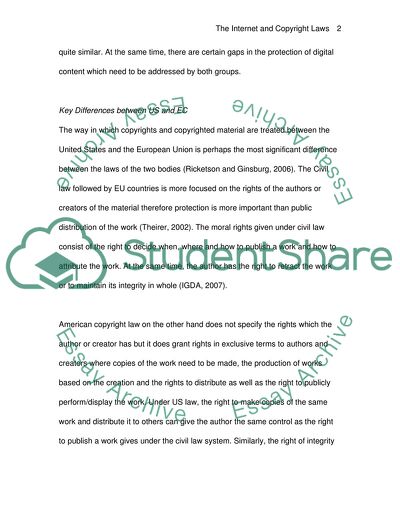
- Home
- Free Samples
- Premium Essays
- Editing Services
- Extra Tools
- Essay Writing Help
- About Us
- Studentshare
- Subjects
- Miscellaneous
- Copyright issues
Copyright issues - Essay Example

- Subject: Miscellaneous
- Type: Essay
- Level: Undergraduate
- Pages: 4 (1000 words)
- Downloads: 0
- Author: hoseaschaden
Extract of sample "Copyright issues"
Of course in certain cases the framework of the law may be less or more than what is required to protect content on the internet along with the dictates of fair use and individual use (Theirer, 2002). However, it does not seem that the laws are redundant since the protection of copyrighted material has to be maintained. In this regard, the EC and the US have certain differences in terms of how they protect copyright but the overall effect of the law towards copyright protection is quite similar.
At the same time, there are certain gaps in the protection of digital content which need to be addressed by both groups. The way in which copyrights and copyrighted material are treated between the United States and the European Union is perhaps the most significant difference between the laws of the two bodies (Ricketson and Ginsburg, 2006). The Civil law followed by EU countries is more focused on the rights of the authors or creators of the material therefore protection is more important than public distribution of the work (Theirer, 2002).
The moral rights given under civil law consist of the right to decide when, where and how to publish a work and how to attribute the work. At the same time, the author has the right to retract the work or to maintain its integrity in whole (IGDA, 2007). American copyright law on the other hand does not specify the rights which the author or creator has but it does grant rights in exclusive terms to authors and creators where copies of the work need to be made, the production of works based on the creation and the rights to distribute as well as the right to publicly perform/display the work.
Under US law, the right to make copies of the same work and distribute it to others can give the author the same control as the right to publish a work gives under the civil law system. Similarly, the right of integrity of
...Download file to see next pages Read MoreCHECK THESE SAMPLES OF Copyright issues
The Problem of Copyright Issues and Public Playing
Gone With The Wind
Music Appreciation
Copyright, Patents and Trademarks: A Piracy and Copyright Issues
Cyber Space Law: Viacom versus YouTube Case
South Korean High School Students Knowledge
Managing Copyright, Ethics, and Privacy in an IT Environment
Copyright Issues and Technology Protection Measures

- TERMS & CONDITIONS
- PRIVACY POLICY
- COOKIES POLICY